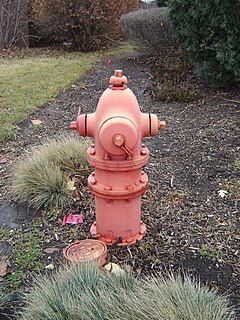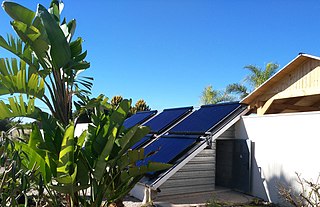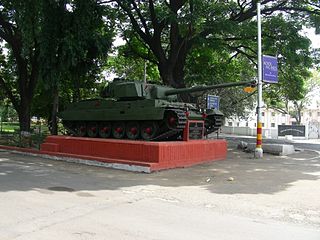
Artillery is a class of heavy military ranged weapons built to launch munitions far beyond the range and power of infantry firearms. Early artillery development focused on the ability to breach defensive walls and fortifications during sieges, and led to heavy, fairly immobile siege engines. As technology improved, lighter, more mobile field artillery cannons developed for battlefield use. This development continues today; modern self-propelled artillery vehicles are highly mobile weapons of great versatility generally providing the largest share of an army's total firepower.
Electrothermal-chemical (ETC) technology is an attempt to increase accuracy and muzzle energy of future tank, artillery, and close-in weapon system guns by improving the predictability and rate of expansion of propellants inside the barrel.
A rifle is a long-barrelled firearm designed for accurate shooting, with a barrel that has a helical pattern of grooves ("rifling") cut into the bore wall. In keeping with their focus on accuracy, rifles are typically designed to be held with both hands and braced firmly against the shooter's shoulder via a buttstock for stability during shooting. Rifles are used extensively in warfare, law enforcement, hunting and shooting sports.

A tank is an armoured fighting vehicle designed for front-line combat and intended as an offensive weapon on a tactical and strategic level. Tanks are a compromise of heavy firepower, strong armour, and good battlefield manoeuvrability provided by tracks; usually their main armament is mounted in a turret. They are a mainstay of modern 20th and 21st century ground forces and a key part of combined arms combat.
The MG 42 is a 7.92×57mm Mauser general-purpose machine gun designed in Nazi Germany and used extensively by the Wehrmacht and the Waffen-SS during the second half of World War II. Entering production in 1942, it was intended to supplement and replace the earlier MG 34, which was more expensive and took much longer to produce, but both weapons were produced until the end of World War II.

High-explosive anti-tank (HEAT) is a type of shaped charge explosive that uses the Munroe effect to penetrate thick tank armor. The warhead functions by having the explosive charge collapse a metal liner inside the warhead into a high-velocity superplastic jet; this superplastic jet is capable of penetrating armor steel to a depth of seven or more times the diameter of the charge. The jet's effect is purely kinetic in nature; the round has no explosive effect on the target.

A fire hydrant or firecock (archaic) is a connection point by which firefighters can tap into a water supply. It is a component of active fire protection. Underground fire hydrants have been used in Europe and Asia since at least the 18th century. Above-ground pillar-type hydrants are a 19th-century invention.

Injection moulding is a manufacturing process for producing parts by injecting molten material into a mould, or mold. Injection moulding can be performed with a host of materials mainly including metals, glasses, elastomers, confections, and most commonly thermoplastic and thermosetting polymers. Material for the part is fed into a heated barrel, mixed, and injected into a mould cavity, where it cools and hardens to the configuration of the cavity. After a product is designed, usually by an industrial designer or an engineer, moulds are made by a mould-maker from metal, usually either steel or aluminium, and precision-machined to form the features of the desired part. Injection moulding is widely used for manufacturing a variety of parts, from the smallest components to entire body panels of cars. Advances in 3D printing technology, using photopolymers that do not melt during the injection moulding of some lower temperature thermoplastics, can be used for some simple injection moulds.
Cooking off is ammunition exploding prematurely due to heat in the surrounding environment.

Solar water heating (SWH) is heating water by sunlight, using a solar thermal collector. A variety of configurations is available at varying cost to provide solutions in different climates and latitudes. SWHs are widely used for residential and some industrial applications.

A smoothbore weapon is one that has a barrel without rifling. Smoothbores range from handheld firearms to powerful tank guns and large artillery mortars.

The C1 Ariete is the main battle tank of the Italian Army, developed by Consorzio Iveco Oto Melara (CIO), a consortium formed by Iveco and OTO Melara. The chassis and engine were produced by Iveco, while the turret and fire-control system were supplied by OTO Melara. The vehicle carries the latest optical and digital-imaging and fire-control systems, enabling it to fight day and night and to fire on the move. Six prototypes were developed by 1988, which were subject to intensive testing the following year during which the vehicles travelled a combined 16,000 km. Deliveries were first planned for 1993, but in fact took place in 1995 due to delays. Final delivery occurred 7 years later in August 2002.

A tank gun is the main armament of a tank. Modern tank guns are large-caliber high-velocity guns, capable of firing kinetic energy penetrators, high explosive anti-tank rounds, and in some cases guided missiles. Anti-aircraft guns can also be mounted to tanks.

A paintball marker, also known as a paintball gun, paint gun, or simply marker, is an air gun used in the shooting sport of paintball, and the main piece of paintball equipment. Paintball markers use compressed gas, such as carbon dioxide (CO2) or compressed air (HPA), to propel dye-filled gel capsules called paintballs through the barrel and quickly strike a target. The term "marker" is derived from its original use as a tool for forestry personnel to mark trees and ranchers to mark wandering cattle.
Paintball is an equipment-intensive sport and in order to safely conduct a game, every player requires a marker with propellant to fire the paint, a mask to protect the eyes and face, paintballs, and a loader to hold them. To ensure safety off the playing field, a barrel sock or plug for the marker is also compulsory.

The K2 Black Panther is a next generation South Korean main battle tank designed by the South Korean Agency for Defense Development and manufactured by Hyundai Rotem. Developed as a modern main battle tank that will replace most of the remaining M48 Patton tanks and complement the K1 series of main battle tanks currently fielded by the South Korean military, the K2 Black Panther combines an auto-loaded 55 calibre 120 mm main gun, advanced composite armour along with hard and soft-kill active protection systems. Mass production commenced in 2013 and the first K2s were deployed with the armed forces in June 2014. The K2 costs over US$8.5 million per unit, making it one of the most expensive main battle tanks in service, of any nation.

Thermal spraying techniques are coating processes in which melted materials are sprayed onto a surface. The "feedstock" is heated by electrical or chemical means.

The Vickers MBT is a series of main battle tanks (MBTs) developed as a private venture by British company Vickers-Armstrongs for export. The design makes use of proven components, such as the L7 gun of the Centurion, the Leyland L60 multi-fuel engine, the transmission and fire control system of the Chieftain. Many tanks were also built by India under licence as the Vijayanta.

The General Dynamics Land Systems (GDLS) M60-2000 or 120S was an upgrade of the M60 tank. The development of the M60-2000 was primarily due to the large number of M60 Main Battle Tanks in service with many Middle Eastern nations unable to afford a sufficient force of more modern main battle tanks. The upgrade was marketed at those M60 users with the industrial capability to convert the tanks themselves. The M60-2000/120S was a GDLS supplied conversion kit that married the M1A1 turret of the M1 Abrams to the M60A1 hull of the M60 Patton, offering many features of the M1A1 Abrams to existing M60 users at a reduced cost.

The Royal Ordnance L11A5, officially designated Gun 120 mm Tk L11, is a 120 mm L/55 rifled tank gun design. It was the first of NATO's 120mm Main Battle Tank guns which became the standard calibre for Western tanks in the later period of the Cold War. By 2005, a total of 3,012 L11 guns were produced. List price was US $227,000 (1990).
















